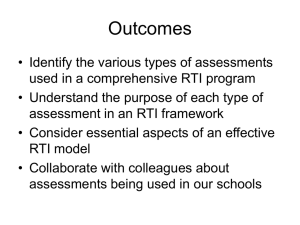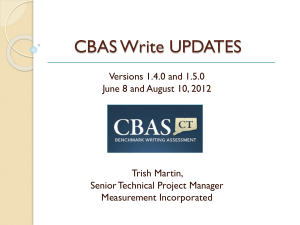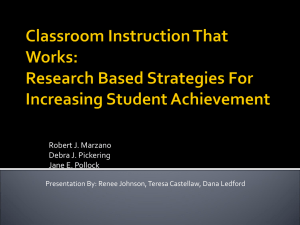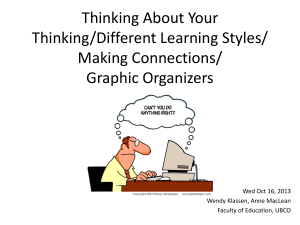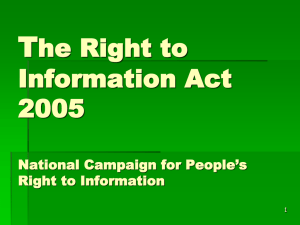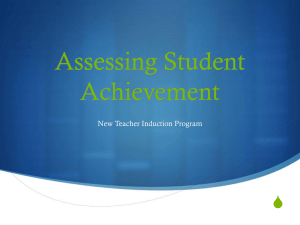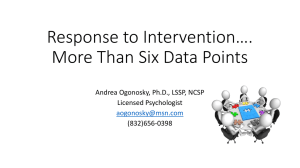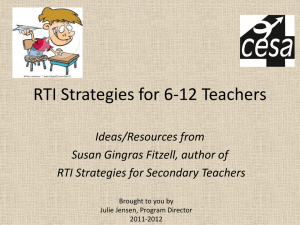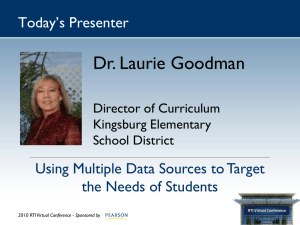The RTI Model: RESPONSE TO INSTRUCTION
advertisement
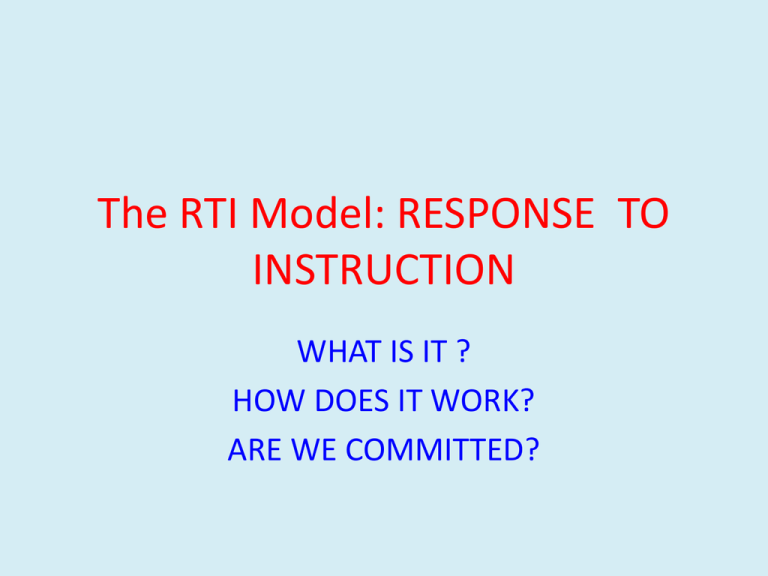
The RTI Model: RESPONSE TO INSTRUCTION WHAT IS IT ? HOW DOES IT WORK? ARE WE COMMITTED? Response To Intervention • RTI is the practice of providing • high-quality instruction and intervention • matched to student need, monitoring • progress frequently to make decisions • about change in instruction, differentiation or goals and applying child response data to important educational decisions. • (NASDSE, 2005) What Happens When Kids Don't Learn ? • High expectations for success will be judged not only by the initial staff beliefs and behaviors, but also by the organization’s response when some students do not learn.” • ~ Larry Lezotte ~ We Must Remember… • No system of interventions can compensate for weak and ineffective teaching. At the same time a school is working to develop time and support for student learning, it must take steps to create the powerful collaborative teams and common assessments that contribute to adult learning. • Core curriculum must be solid, and delivered with FIDELITY. Without this, the system of intervention will be overwhelmed. Beliefs • Do we believe it is the purpose of our school to ensure that all students learn at their highest potential? • Do we acknowledge that students learn at different rates and with different levels of support? • Have we created a schedule that guarantees students will receive additional opportunities for learning, in a systematic way, regardless of who the teacher might be? PASSION STATEMENT • We at Mintie White will not rest until students and teachers are purposefully engaged and invested in ongoing, meaningful, systematic learning. • Teachers and students effectively collaborate in an environment where everyone’s ideas are heard, validated and honored in order to advance each student. ASSESSING OUR SCHOOL • Are our students assured EXTRA TIME AND SUPPORT? • Is our response TIMELY? How quickly are WE able to identify the kids who need extra time and support? • Is our response prompt intervention or sluggish remediation? • Is our response SYSTEMATIC? Do kids receive this help according to a school-wide plan? If you answered “NO”… • You probably are wondering… – How to organize? – Where is the money? – Where are the people? – Where is the time? – What does it look like? • WHAT IS RTI? • Read article RTI: RESPONSE TO INTRUCTION A Process not a Program 3 components combined for success: Collaboration, Scaffolding, Ongoing Assessment throughout school, and within grade levels Staff created schedule which disperses support staff, special ed staff, throughout grade levels in order to lower student to teacher ratio in reading for the lowest levels. Flexible Grouping 45minutes per day Meets the needs of ALL students, gifted,FBB, BB,B,Pros , Adv etc and Special Needs kids Students are moved to another level at any time based on assessments It is NOT TRACKING: It only encompasses part of a day Instruction is at instructional level: Creates success and promotes high interest Provides 3-4 times more direct instruction What it is Not……. •A program with a prescribed set of rules •Programs that have to be purchased to make it happen •Time in addition to the Language Arts Block •TRACKING…where students must remain in the same level all year •A cookie cutter approach where a system is super-imposed over a school and they must conform to a program •Top-down direction that includes “RTI POLICE” watching that it is done “ correctly” •A way to get “RID” of special education •Only successful if there is a certain amount of support people in a school •A fixed creation that must always be the same with no room for adaptation •Teachers planning in isolation for their level of instruction and not utilizing the problem solving methods of collaboration. Benefits of RTi • Grade levels receive higher scores on assessments • Teachers streamline instruction due to smaller range of developmental levels in reading class • Collaborations ensure teaching of Power Standards that are mastered • INCLUSION of SPECIAL ED STUDENTS • ALL students can learn what they need to. What will it take? • Inclusive leadership: teachers as leaders • Continual Collaboration: PLCs,DATA TEAMS, lesson planning, assessments, dialogue • Resources need to be lined up . • Visits to other RTI schools • TRUST your colleagues with your students! • Schedule by Grade Levels • Letting go of “comfortable” structures until it flows. • Believing it is the best for our students. Benefits for Students? • Students with behavior problems will decrease. • Struggling students will feel less overwhelmed and frustrated • Accelerated students can go higher are no longer bored • Costs are minimal • Differentiated Instruction: Reading and Writing Workshop? Skills taught that are needed to access regular classroom program. Have a Passion • Olga does not say “Do this, or You have to” • You will need to make a personal commitment to the process by agreeing to the passion statement made by your peers • Some staff will be skeptical,”I’ve seen it all!” • Some don’t want to change what is working right now.” • Olga will support you and will help protect your time. K-1 Model 5 min.----Letter/Sound review ( letter sound recognition and building phonics skills) 5-10 min---Sightword Vocabulary ( inmediate recognition for transference to text ) 5-10 min.-----Phonemic Awareness 20 min. Guided Reading ( reading strategies,build comprehension, observe reading behaviors) Dictate and Write: Put together learning in a meaningful way 2-5 Model for Intensive Students Using Power Standards and DATA: 3 Rotations o Word Skills: Letters and Sounds: Follow sequence of Word Skills o Literary Analysis: Leveled Reading materials: Work on Comprehension o Graphic Organizers o Reading Standards: Across Grade levels o Use of Adopted Materials ( HM) o Other materials on standard being taught 2-5 Model Benchmark Group Word Skills: Letters/Sounds, Greek/Latin prefixes, suffixes, roots Literary Analysis: leveled reading, Beginning novels,Literature Circles, Readers Workshop, Graphic organizers Articulation of Power Standards: ie. Main Idea Use of adopted Curriculum ( HM) to : Build background, vocabulary, story,workbook pages Graphic organizers and additional materials on Standard Enrichment 2-5 Model • Word Skills: letters and Sounds, Greek/Latin Prefixes, suffixes, Roots • Literary Analysis: Novels, Literature Circles,Graphic Organizers, response to Literature Reading Standards: Articulation of Power Standards: ie. Main Idea Use of adopted Curriculum ( HM) to : Build background, vocabulary, story, workbook pages Graphic organizers and additional materials on Standard What Would It Take? •Commitment , TRUST, Communication, Planning •Determine who does what at each level •Determine materials used and needed •Determine Assessments used at each grade level. •Make visits to Rosemary and other places to see it in action •Provide Support Staff Training on grade level Expectations How many of the things mentioned are we already Doing ? Time Commitment? •45-50 minutes a day •4 days a week •SAMPLE: •8:10-9:00 4/5 grade •9:15-10:00 3rd grade •10:05-10:55 1/2 grade The Mintie White Support Team EQUITY for All Students Suggestions and Possibilities 4/5: Jan, Jose, Terry, Nancy, ? 3: Jan, Tony, Jose, ? 1/2: Jan, Lynn, Jose, Tony, ? The hard question we need to answer in Response to Instruction is Are we using our resources in the best way to meet the needs of as many kids as we can? DATA FBB BB Ba Grades Blue= 3 Orange=4 Pro Adv Green=5 Data says that we have many students to move forward who’s needs are not being met. How do we do this and not flat line? AYP standards have gone up to 56% of our students must be proficient to stay in Safe Harbor and get out of PI status. Reflections 1. Can we start one level at a time? 2. What grades may want to look at implementing this PROCESS in January? 3. What grade levels might be interested in exploring options to providing equity across the school using our resources? 4. What do we have to be faithful to if we do not respond to instruction using this model? Ie. Quality of UA time? How are we ensuring that the necessary reading skills are being taught daily and systematically? Interventions? 5. If we really put our effort this year to get out of PI status, it could free us of mandates and allow for more creative teaching. How can we continue as A WHOLE SCHOOL to work towards this? Thanks, the decision is yours. Shared leadership means that , exactly. What will you do as a team to ensure that all students’ needs are met at every level. We can do it our way in an equitable fashion. THE BIG DECISION Second grade would pilot and begin in January Visit Rosemary for grades 1,2,3 Third grade will begin in February First Grade will visit Second and third grade and will begin planning Olga will get materials bought and ready Reading Teachers will be hired by the hour to push in. Teachers will test students for placement . Grade levels will begin to place students in target groups Look at DATA Scheduling COLLABORATION days given to team by Olga Lot’s of Kudos all of the way around Teachers Shine within their own school No need to visit other schools when you have success at your own school.
